
"The Revolutionary Singer Model 301 Slant-Needle Sewing Machine"
"Represents the Ultimate in Sewing Machine Design and Styling"
"The Slant-Needle Sewing Machine Is All About Precision"
"The World's Finest Straight Stitch Sewing Machine"
"The Most Modern, Streamlined Machine Ever"
"The Best Sewing Machine Ever Made"
"The Last Word In Sewing Ease"
"The Famous Singer 301"
"Read About Me"
"Legendary"
"301"
![]()
Slant-Needle
After World War II, 1939-1945, most sewing machine manufacturers were marketing the same machines they sold prior to the war. Singer with the Models 99-13, 128, 66-18, 15-88, 15-91, 201 and 221. There was a very desperate need for change with not only the family sewing machine but also for educators and high school home economic classes.
Fortunately, Singer was already engineering a new machine to introduce for its 100th Anniversary that would revolutionize the sewing-machine-of-tomorrow with a dramatic departure in design to make home sewing easier and more convenient. A machine unlike any other in the past 100 years of sewing machine production.
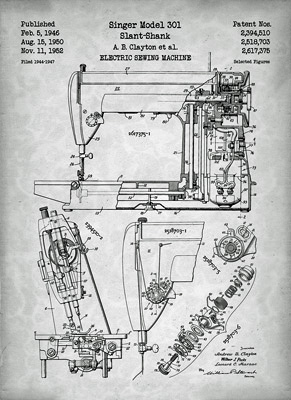
Singer Model 301 Slant-Shank
Filed 1944-1947 / Published 5 Feb 1946, 15 Aug 1950, 11 Nov 1952
On 17 November 1944 Singer Manufacturing Company applied for a patent with an invention that relates to sewing machines and it has a primary objective to provide an improved sewing machine which will afford better visibility at the stitching point. The needle-bar and the presser-bar are inclined rearward between eight and sixteen degrees to a vertical plane. It has been found that if the parts are inclined less than about eight degrees from vertical a clear stitching point is not obtained and the machine elements are located in such a position that they are likely to be contacted by the operator's head or face when they lean forward.
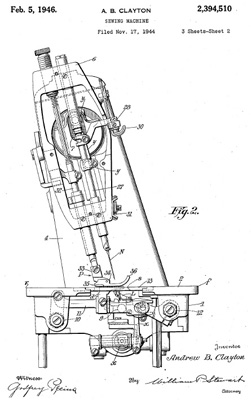
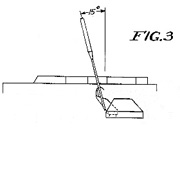
15 degree inclined needle-bar
Patented to Singer Manufacturing Company on 5 February 1946
When the parts are inclined greater than 16 degrees, the point of the needle does not always penetrate certain types of materials but tends to be deflected upward, thereby sometimes resulting in the skipping of stitches or in the breaking of needles. Also, with the presser-bar arranged at an angle greater than sixteen degrees to the vertical, the pressure-foot has, combined with its downward movement, and endwise movement which tends to push the work towards the front of the machine, and in a direction opposed to the direction of movement of the work by the feeding mechanism, which is objectionable. The original design for a 15 degree inclined needle-bar was later changed to a 9 degree inclined needle-bar that was perfect.
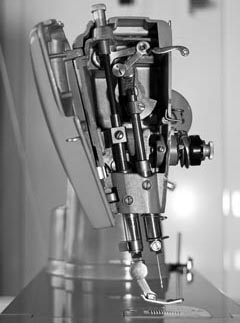
The Slant-needle sewing machine has a 9 degree inclined Needle-Bar
The inclined needle bar would become known as the "Slant-needle" and engineering of this new machine would continue over the next several years. During that time Singer started construction on the new Anderson, South Carolina factory that was being built to specifically manufacture the new slant-needle sewing machines.
On 27 March 1951, Singer's Elizabethport factory located in Elizabeth, New Jersey manufactured a pilot run of 30 Model No. 301 machines with the following serial numbers; AK257721-AK257750. These 30 machines went through rigorous testing and inspection of parts for several months as it was an entirely new sewing machine.

None of these 30 test machines have ever been located, most likely destroyed after testing.
The new Slant-needle sewing machine would not only be marketed as a "Family Sewing Machine" but also as the "Slant Shank System" to educators and high schools that wanted the most reliable machine able to withstand the daily abuse from high school students. Singer felt that the education system would produce a new generation of sewers raised on the slant shank or Slant-needle sewing machines.
Singer built an entirely new style electric family sewing machine, embodying many exclusive features that simplify operation, making sewing a pleasure. Made of die-cast aluminum for light weight and sturdiness. It has a concealed, built in electric motor which drives the machine through gears at any desired speed. A built-in electric SINGERLIGHT illuminates the work. The machine has a vertical rotary hook on a horizontal axis that makes a lockstitch. It has a reverse feeding mechanism which enables you to sew either forward or backward direction, making it easy to back-tack and to fasten the end of seams. A convenient feed throw-out device, which renders the feed inoperative, permits darning and embroidering to be done without the use of the feed cover. It has a nine degree inclined needle-bar and pressure bar for easy vision of work. The inclined needle-bar referred to as a Slant-needle would utilize slant shank feet. Engineered for precision, sewing ease, extremely reliable, built to be sturdy and withstand daily use and abuse, and last a lifetime.
It would be the first family sewing machine ever made that was a cabinet and portable all in one. You can raise the handle and lift the machine out of the cabinet and carry it anywhere. The first family sewing machine to sew up to 1,600 stitches per minute. Singer craftsmen took 100 years of engineering knowledge and built an amazing machine that represented the ultimate in sewing machine design and styling. This new Slant-needle sewing machine would be known as the revolutionary "Singer Model 301".
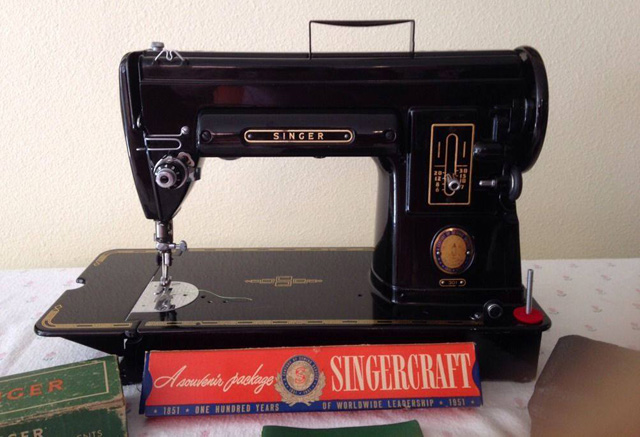
The Revolutionary "Singer Model 301" Slant-Needle Sewing Machine in 1951
Singer Model 301 - Stitch Type 301
Interestingly, the new "Singer Model 301" straight stitch sewing machine has the same number as the stitch type it sews - "Stitch Type 301". Was it simply a coincidence or was it Singer's intent to name this new revolutionary machine after the stitch it sews. After all, it was Singer's 100th Anniversary and the revealing of the new "Singer Model 301". Makes you wonder!
The "Stitch Type 301" as defined in the United States Government Specification Booklet 751 A: The 300 stitch class includes stitch types that interlock a needle and thread with a bobbin thread by the use of a hook or shuttle mechanism. Because these threads are interlocked rather than interlooped, the 300 class is better known as the "Lockstitch" class of stitches.
The most popular stitch formation in the 300 series is the 301 stitch which is often referred as a "plain stitch", "straight stitch", or plain "lockstitch". In the 301 stitch formation, needle thread which is supplied from a cone of thread is passed through the material and carried around a bobbin which has been wound with thread. The needle thread it than pulled up into the middle of the material carrying the bobbin thread with it. The ratio of needle thread to bobbin thread consumed in the 301 stitch should be 1 to 1 in a well balanced stitch formation.

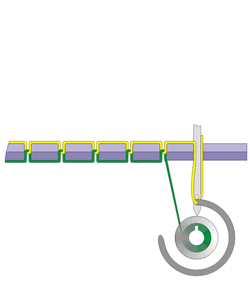
The type 301 stitch is the most popular stitch, reasons for its widespread use include:
-
the stitch is reversible and looks the same on both sides;
-
it is the tightest stitch formation which minimizes seam grinning;
-
stitches are secure, higher strength and extensibility (30%);
-
more secured than the chain stitch;
-
it consumes the least amount of thread in its formation;
-
it has better "hand", or feels smoother to the touch;
-
lockstitch machines are very versatile and can be used on a variety of operations.
The U.S. Military set up the standard specification system for seam construction and stitch types that is still widely used today in the garment and sewn products industries. Federal Specifications: DDD-S-751 - Stitches; Seams; and Stitching - Stitch Type 301. The latest version of this specification is 751A - Stitch Type 301. The specification has also been adopted by the International Standards Organization - ISO 4915 -standard for stitch and seam specifications - ISO#301 (lockstitch).
It does, however, seems appropriate for the "Singer Model 301" - "The Worlds Finest Straight Stitch Sewing Machine" to have the same number as the "Stitch Type 301" it sews.
Doehler-Jarvis and Singer Manufacturing Company
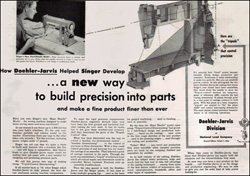
How Doehler-Jarvis Helped Singer Develop ...
a new way to build precision into parts and make a fine product finer than ever.
Have you seen Singer's new "Slant-Needle" model ... the sewing machine designed to make home sewing easier and convenient?
In one minute it can throw up to 1,500 stitches into your lady's crinolines. It's the only combination portable and cabinet model on the market. (Conversion from one type to the other takes only seconds.) Yet the machine, including motor only weighs 16 pounds.
Singer can tell you that it's quite a chore to build features into a machine like this ... and still keep it competitive. And they're frank to give Doehler-Jarvis major credit for making their job easier with a new method for designing and producing precision parts. We call this precise new way of making things, "Tripod-Control Dimensioning".
It all started back in 1935 when Singer Manufacturing Company ask Doehler-Jarvis to help pioneer the first die cast aluminum sewing machine components.
To meet the rigid precision requirements, Doehler-Jarvis engineers devised what may have been the first ground and hardened toolsteel casting die ever used. It had its faults, but it did give them machine-tool accuracy. And they discovered the germ of the "Tripod-Control" idea.
What had been discovered was the way to extend a familiar two-dimensional control . . . "baseline dimensioning". . . to the control of precision in three dimension. With it they could control precision of and between two (or more) die castings of an assembly. They selected a point of vantage common to the parts. Through the point was established a "tripod" of reference from which all critical angles and dimensions could be controlled. Errors vanished. Precision went up . . . assembly troubles down.
Then the idea spread in both the Doehler-Jarvis and the Singer plants. It was used to make multiple jigs. . . used as the basis for ganged machining. . . used in finishing. . . used in assembly.
By the time the "Slant Needle" model came along, "Tripod-Control Dimensioning" had grown to a full-fledged design and production technique . . . based on die casting . . . used even in the first rough sketches of the new product . . . used in the planning stages . . . used throughout tooling and production.
Today? Well . . . you never saw production flow more smoothly when complex precision parts are made by one company, finished and assembled by another.
Singer Model 301 Slant-Needle Sewing Machine
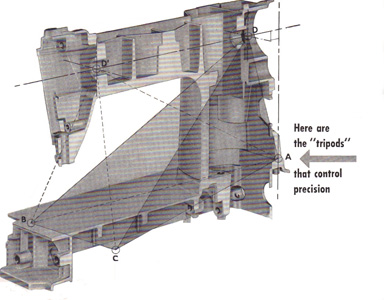
Tripod-Control Dimensioning made of die-cast aluminum for precision, light weight and sturdiness!
In the photo above the two major Doehler-Jarvis die castings that frame "Singer's new Model 301" have been assembled, then sliced down the middle to show the (Tripod-Control) method. An imaginary plane of reference, A-B-C, controls the bed casting. It passes through point A, a real point of vantage common to both parts. With this plane as a base, imaginary "tripods" are erected to "fix" the plane A-D-D' and control arm-casting dimensions. The same plane controls precision measurements in all following operations.
Although the article states; In one minute it can throw up to 1,500 stitches into your lady's crinolines, it was a very conservative estimate for the article. The Model 301 tested at ±1,600 stitches per minute.
The "Singer Model 301" is all about "Precision" in Every Way!
The new Slant-needle "Singer Model 301"
-
Revolutionized the sewing-machine-of-tomorrow with a design to make home sewing easier and more convenient.
-
1st Slant-needle sewing machine, making it easier to see what you are sewing.
-
1st and Only electric Singer sewing machine ever made that is a cabinet and portable all in one. Full-sized, Full-fledged cabinet machine - that you can use as a portable. You can raise the handle and lift the machine out of the cabinet and carry it anywhere.
-
1st sewing machine with almost all moving parts concealed. Even the bobbin winder can be pushed down and concealed into the machine. The Singer-light is built into the arm of the machine.
-
1st sewing machine using Tripod-Control Dimensioning made of die-cast aluminum providing precision, light weight and sturdiness. Weighs only 16 pounds.
-
1st sewing machine with a modern-streamlined design, entirely new style of electric family sewing machine.
-
1st sewing machine with flexible spool pins that won't snap or break.
-
1st family sewing machine to sew up to 1,600 stitches per minute.
Slant-Needle "Singer Model 301" Hand Needles Advertisement
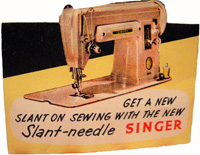
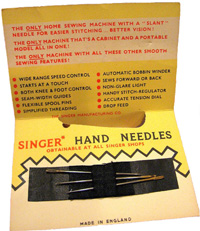
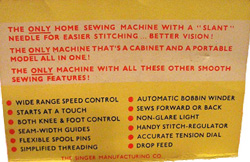
The ONLY Home Sewing Machine With A "Slant" Needle For Easier Stitching...Better Vision
The ONLY Machine That's a Cabinet and a Portable Model All In One
The ONLY Machine With All These Other Smooth Sewing Features
* Wide Range Speed Control * Starts at a Touch * Both Knee & Foot Control * Seam-Width Guides
*Flexible Spool Pins * Simplified Threading * Automatic Bobbin Winder * Sews Forward or Back
* Non-Glare Light * Hand Stitch Regulator * Accurate Tension Dial * Drop Feed
Principal Parts of a Singer Model 301
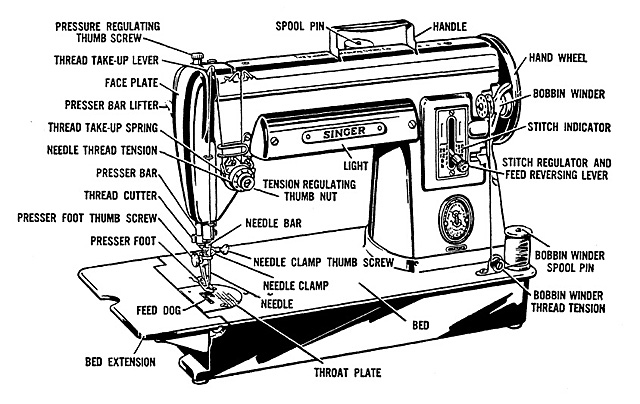
Singer 301 Features
-
Smoother Stitching than ever before is possible with this new, gear-driven, lockstitch machine.
-
Quiet, fast and efficient - it whispers at high speeds.
-
Speed: up to 1,600 Stitches Per Minute (SPM)
-
Stitch Mechanism: Vertical rotary hook on a horizontal axis and makes the lockstitch, Stitch Type 301.
-
Full-View work area with a 9 degree inclined needle bar places work in your direct line of vision.
-
Perfect Control even at "hand-stitch" speeds.
-
Balanced Motion of the new Singer 301 prevents vibration.
-
Easy Starting - No coaxing necessary - lightly press the knee or foot control and your 301 starts to sew.
-
Simple Threading - no complicated diagrams are needed.
-
Reversible Feed for sewing either in a forward or backward direction - easy to back tack and to fasten ends of seems.
-
Prefocused Singerlight illuminates working area - prevents eye strain.
-
Calibrated Stitch Regulator permits finger-tip control of stitch length.
-
Stitching Guides, with graduated markings to guide seam width and turn square corners.
-
Versatile - use it as a portable or cabinet machine.
-
Easy To Carry - convenient handle is concealed in top of head.
-
Light Weight - full-sized aluminum head weighs only 16 pounds.
-
Self-Setting Needle makes it impossible to insert needle incorrectly in clamp.
-
Feed Throw-Out Device permits darning and embroidering without attachments.
-
Recessed Bobbin Winder - equipped with automatic stop - it can't break or tangle your thread.
-
Hinged Bed Extension permits quick and easy removal of bobbin.
-
Hinged Face Plate - Simplifies cleaning and oiling.
-
Dual Tension takes the guess work out of upper tension setting.
-
Flexible Spool Pins - bend but do not break - thread unreels smoothly and easily.
-
Completely Enclosed motor and principal working parts insure maximum safety.
The "Singer Model 301" Slant-Needle sewing machine is unlike any sewing machine ever built,
100 years of engineering knowledge and Singer thought about everything with the Singer 301.
Singer Celebrates 100th Anniversary
The Singer Manufacturing Company celebrates 100th Anniversary, marked by the issued patent of the first Singer sewing machine on August 12, 1851. To celebrate this milestone, they introduced the "Anniversary Model" as the new Slant-needle Singer Model 301 that would revolutionize the sewing-machine-of-tomorrow with a design to make home sewing easier and more convenient.
The new Slant-needle Singer 301 Anniversary Model and the original Singer sewing machine were on display at the Historical Collection exhibition of new and old Singer sewing machines in New York from 16-30 September during the 100th Anniversary of the patenting of the first Singer sewing machine.
The Historical Collection exhibition was also displayed during the month of November for the 100th Anniversary celebrated at the South Bend, Indiana factory where they crafted wood cabinets for Singer sewing machines.
Historical Collection Exhibition of New and Old sewing machines
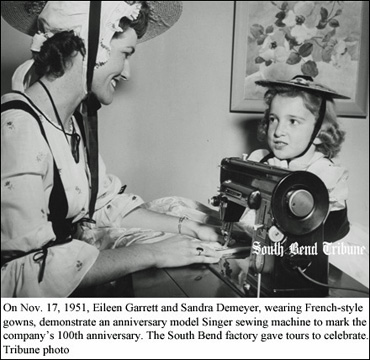
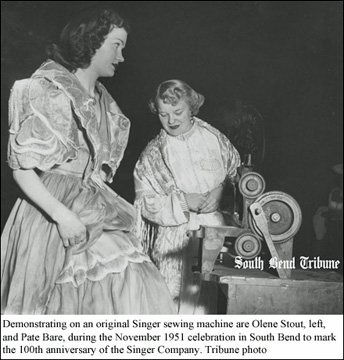
The new 1951 "Singer 301 Anniversary Model" The old 1851 "Original Singer Sewing Machine"
The new Slant-needle Singer 301 is the "Anniversary Model" to mark the company's 100th Anniversary.
After Singer's 100th anniversary this "Singer 301 Anniversary Model" was part of the Historical Collection in the Singer Archives, located in the Singer Building/Tower at 149 Broadway, New York City, New York. In 1967, the Singer Building/Tower was demolished and nobody knows what happened to this "Singer 301 Anniversary Model".
1950 Chevrolet Sedan Delivery
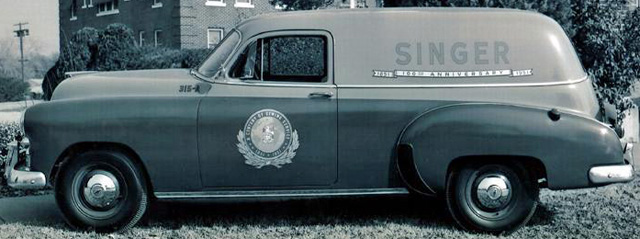
1950 Chevrolet Sedan Delivery
*Photo courtesy of Bernard and his father who worked at Singer Mfg. Company from 1948-1960
During the "Centennial Year" you would most likely see a "1950 Chevrolet Sedan Delivery" with the Singer Centennial emblem 100th Anniversary pull into your driveway to deliver a brand new Singer Model 301 sewing machine and sewing cabinet. This is an exceptionally rare photo of a 1950's Singer delivery vehicle.
Singer 301 Anniversary Limited Edition

Anderson factory original company register A2 log of "NA" Series Register Numbers
The "NA" Series Register Numbers shows that on 25 July 1951 Singer allotted a "Limited Production Run" of 10,000 Singer Model 301 sewing machines, NA000001-NA010000, as the "Anniversary Model" to commemorate Singer's 100th Anniversary. This was over a year before they were originally announced and released after its Grand Introduction in October 1952. The correct terminology in 1951 is "Singer 301 Limited-Production Anniversary Model" referred to as "Singer 301 Anniversary Limited Edition".
1,000, NA000001-NA001000, have a Blue Centennial Badge, "Singer 301 Centennial Limited Edition"
9,000, NA001001-NA10000, have the new Black Band Badge, "Singer 301 Anniversary Limited Edition"
The "Anniversary Model" to mark the company's 100th Anniversary!
Made in 1951
It used to be a common belief that all "NA" serial numbered sewing machines were made in 1951. To this very day, if you call Singer's customer service they will tell you your "NA" serial number has a "Year of Issue" of 1951. This is because they have no records from the Anderson factory and with no choice but to use the misleading records from Elizabeth, New Jersey when they issued one million "NA" serial numbers, NA000001-NA999999, on 29 May 1951. Singer models 301, 301A, 401A and 403A all have "NA" serial numbers but were not manufactured until 1952, 1953, 1956 and 1958, respectively. The fact is "only" 10,000 sewing machines with "NA" serial numbers were allotted to be manufactured in 1951 during Singer's 100th Anniversary.
-
Up to March 1996 you could call Singer Customer Service with your serial number and they would give you a "Birth-Date" of 29 May 1951 for all "NA" serial numbers. This is inaccurate!
-
From April 1996 to 2005, Singer Customer Service used the Sewing Machine Blue Book dates of 1953-1959 for all "NA" and "NB" serial numbers. This is inaccurate!
-
From 2005 to 2013, Singer Customer Service gives a "Year of Issue": "NA-1951, NB-1956, NC-1961. This is inaccurate!
-
Today, if you go to Singer's website they refer the Singer Sewing Machine Serial Number Database to the International Sewing Machine Collectors Society (ISMACS International). ISMACS lists Anderson Year of Issue for "Letter NA Series" 1951 to 1959, "Letter NB Series" 1959 to 1961 and "Letter NC Series" 1961. This is inaccurate!
The only record from the Anderson factory is from 1951. What happened to the 1952-1963 "Series Register Numbers" log books is still a mystery, but one story, that might be true, is they were burned in an office fire.
1952-1957
The majority of Singer 301/301A sewing machines where made between 1952-1957. In 1952 production started on the Model 301 at the Anderson factory in South Carolina and were shipped to Singer Sewing Centers prior to the Grand Introduction of the Singer Model 301 in October 1952. In 1953 the suffix "A" was added to the model number, 301A, to signify it was made in Anderson, South Carolina. In 1955 the last "NA" serial number was used and in 1956 the start of the "NB" serial numbers. End of production was in 1957. There were 690,000 machines made between 1952-1957 and 10,000 from 1951 for a total of 700,000 Singer Model 301/301A sewing machines.
Anderson, South Carolina
What is the Story about the "A" after the Model Number
Due to massive expansion of Singer factories around the globe a letter suffix, after the model number, was used to denote where the sewing machine was manufactured. The Singer Manufacturing Company opened the Anderson, South Carolina plant to specifically manufacture the new Slant-needle model sewing machines. The Singer 301 was the first model to be manufactured and the Model Number Tag was simply 301. Not to get confused with Elizabethport, USA, that did not use a letter suffix, starting in January 1953 Singer identified the Anderson, South Carolina factory by placing the letter suffix "A" after the model number, hence the 301A.
After the last Slant-needle Singer Model 503A sewing machine was manufactured in 1963 the Anderson plant stayed open for many years with 3 manufacturing lines: Sewing Machines, Floor-care products (vacuum cleaners) and Power Tools. The "Athena" electronic sewing machine was made at Anderson.
In August 1988 Singer completed the sale of its two South Carolina plants, Pickens and Anderson factories, which had about 2,500 employees total, to Ryobi Limited of Japan. (Ryobi Corporation) This was several years after the Elizabethport factory located in Elizabeth, New Jersey closed down on 1 December 1982.
Big Sister - Big Brother - Sorry, Wrong Family!
The Singer 301 "is not" a Big Sister, Big Brother or Cousin to the 221 Featherweight, nicknames wrongly used implying they are from the same family. The truth is the Singer Model 301 was an entirely new "Slant-Needle" sewing machine that revolutionized the sewing-machine-of-tomorrow with a design to make home sewing easier. It has nothing to do with the past, but the future, and the beginning of the modern Singer sewing machine.
Singer Slant-Needle Family
Slant-Needle; 301, 301A, 404 Slant-O-Matic; 401, 401A, 403, 411G, 414, 421G, 423, 431G, 500, 500A, 503, Touch & Sew; 600, 600E, 603, 604, 609, 620, 625, 626, 628, 629, 630, 635, 636, 638, 640, 645, 646, 648, 649, 714, 734, 750, 756, 758, 770, 774, 775, 776, Futura; 900, 920, 925, 1000, 1030, 1036, 1100, 1200, 1411, 1425, Athena; 2000, 2000A, Touch-Tronic; 2001, 2005, 2010, 30920, 4552, 4562, 4572, 4610, 4622, 5910, 6233, 6234, 6235, 6267, 6268, 6740, 6800, 6900, 7028, 8019, 9005, 9008, 9010, 9012, 9015, 9018, 9020, 9022, 9027, 9030, 9032, 9044, 9123, 9133, 9135, 9137, 9143, 9210, 9217, 9224, 9240, 9400, 9408, 9410, 9416, 9417, 9420, 9423, 9430, 9432, 9440, 9444, 9900.
The Singer 301 is the Monarch of the Legendary Slant-Needle Family
The New 1951 Black Band Singer Badge
In 1951, Singer changed from the older style gold Singer Badge to a new Black Band Singer Badge on all Singer home sewing machines allotted to be manufactured in July and in stores by October 1951.
~1950
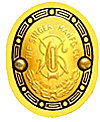 1951~
1951~
Gold Singer Badge Black Band Singer Badge
Singer 301 & 301A Badge Casting Change
Have you ever noticed a difference between the Singer 301 & 301A besides the model tag number? The Singer 301 has a border casting around the Singer Badge, a protruding and more dignified appearance. The Singer 301A had the border casting removed, a simple flat looking appearance.
All Singer 301's have a border casting and a small amount of Singer 301A's up to serial number NA206500.
Take a look at the difference:
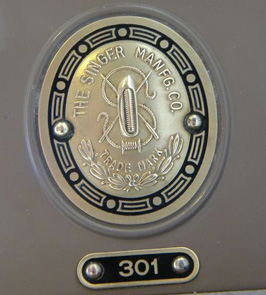

Singer 301 & 301A Singer Badge Casting Change
Colors of the Singer 301 & 301A

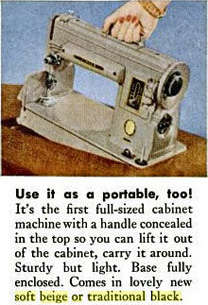
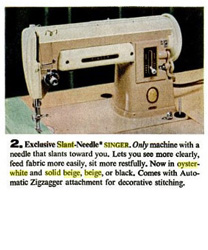
"Soft Beige" or "Traditional Black" Oyster-White and Solid Beige
In all of the Singer advertisements for the new Singer 301/301A only two colors were mentioned, "Soft Beige" and "Traditional Black".
In 1956, Singer changed to a new two-tone color, with all advertisements calling it "Oyster-White and Solid Beige", with the other colors now called "beige or black".
The new "Solid Beige" color is a lighter shade than the "Soft Beige" color. Because of this lighter shade owners called it "Light Beige" that evolved into the lingo used today of "Light Beige Oyster-White" or "LBOW".
Short and Long Extension Beds

The Singer 301 and 301A has either a short or long extension bed. The short bed was used as a cabinet model and the long bed as a portable model that came with a trapezoid carrying case. With the help of the registry we can determine an approximation of short beds vs. long beds.
There were 700,000 Singer 301/301A sewing machines. All 10,000 in 1951 and all 200,000 "NB" serial numbers in 1956-1957 had short beds, that alone is 210,000. From 1952-1955 approximately 60% were short beds and 40% longs beds. The overall average is approximately 70% short beds and 30% longs beds. Now you know why long beds are so much harder to find.
Singer Decalcomania
Decals, also known as "Decalcomania" or "Transfer Prints" were invented in England and began to flourish in the 1850's. Decalcomania is a decorative technique by which engravings and prints are transferred to other materials, such as the body of a sewing machine. Today, the use of the word "Decal" is more widely used but in the Singer factories around the world the use of the word "Transfer" was used.
![]()
Singer Transfer - Transfer No.23 Indian Sphinx - Made in Scotland - Order No.
There is not much information about Singer decalcomania but we do know they were called a "Singer Transfer" with a "Transfer Number" and a "Descriptive Name". A complete "Singer Transfer" was located on one transfer sheet or set, what we call today a "Decal Set". Most of the decal names and numbers used today have been made up over the years because there is no Singer listing with this information. It was therefore necessary to come up with something which is better than nothing.
Singer's printing department was located at the Elizabeth factory in New Jersey and where all the literature was printed, along with badges and transfer sets used for ornamenting the machine heads. Singer's overseas factories had there own printing departments.
Singer 301 & 301A Decal Change
The traditional black color with gold decals, called "transfers", has always been a trademark for all Singer Vintage Sewing machines and is a very important part of Singer History. All Singer 301's & 301A's that are traditional black will have a matching set of gold decals located on the bed, extension bed and the back of the bed arm. It will also have "THE SINGER MANUFACTURING CO." on the very top and "SINGER" on the back.
There were 2 different decal sets used:
-
Singer 301's, up to serial number NA130000, all have a "Paperclip" decal set with a center decal that looks like an "S".
-
Singer 301's and 301A's, after serial number NA130000, all have a "Prism" decal set with a center decal that looks like an "8".
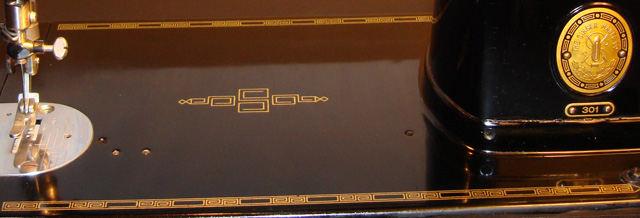
Singer 301 "Paperclip" decal with center decal that look like a "S"

Singer 301A "Prism" decal with center decal that looks like a "8"
Back-Arm Decal
All Singer 301 sewing machines in traditional black have a matching Back-Arm decal except for the Centennials that had a Celtic Chain decal that did not match its Paperclip decals.
-
Serial Numbers between NA000001-NA001000, traditional black, have "Paperclip" decals with a ""Celtic Chain" decal on the Back-Arm.
-
Serial Numbers NA001001-NA13000 have matching "Paperclip" decals.
-
Serial Numbers NA130001-NA500000 / NB065000-NB075000 have matching "Prism" decals.
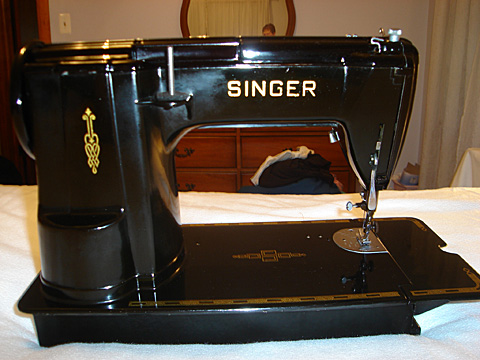
Celtic Chain Decal - Serial Numbers NA000001-NA001000
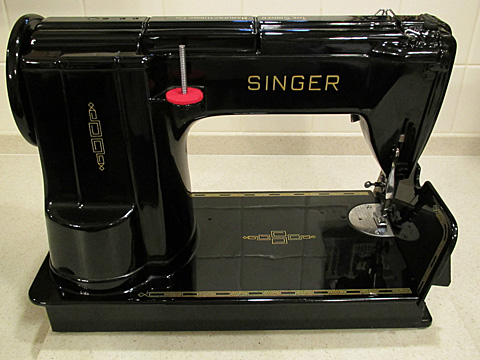
Paperclip Decal - Serial Number NA001001-NA130000
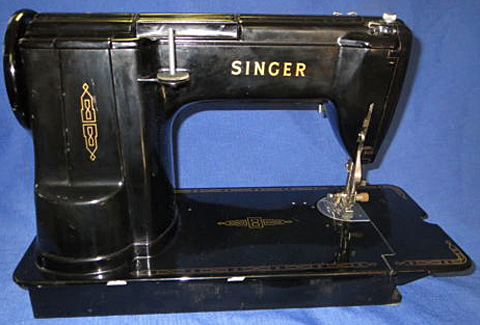
Prism Decal - Serial Number NA130001-NA500000 & NB065000-NB075000
Singer 301 Motor Changes
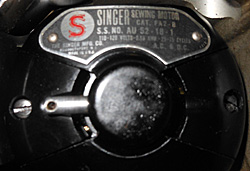

1951-1952 Motor (Silver Lube Tube) "Circle S"
The same .53 amp motor was used in all 301's and 301A's but look closely at the picture above. It has what they call the "Circle S", a "S" inside of a gray circle, located on the left side of the data plate. Serial numbers NA000001-NA050000 have this data plate, 1951-1952.

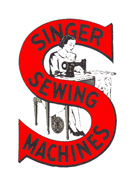
1952-1955 Motor (Silver Lube Tube) "Red S"
From 1952-1955 all 301/301A's have the same motor with the Silver Lube Tube but the data plate changed to what they call the "Red S", "Singer Sewing Machines" is written inside the "Red S" with a lady sewing on a sewing machine, located in the center of the data plate. The change from "Circle S" to "Red S" occurred after serial number NA050000 in 1952.
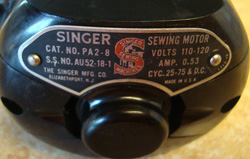
1956 Motor (Silver Lube Tube Removed)
In 1956, the start of the "NB" serial numbers, the motor was changed from a lubricating to a "No Lubrication Required" motor. This new motor did not have the lube tube on the end of the motor but did have the same data plate with the "Red S" emblem used from 1952-1955.
Machine No. 301-1 and 301-2
In the parts manual there are 3 different types of the Singer 301 and 301A sewing machines:
-
The 301-1 is for use with a cabinet, you can still use it as a portable.
-
The 301-2 is for use with carrying case set No. 269. It is sold with the carrying case.
-
The 301-3 is for use with school sewing and cutting table.
Only changes between the 301-1 and 301-2 are shown - the 301-3 is for school use only!
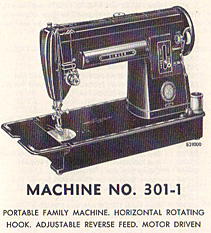
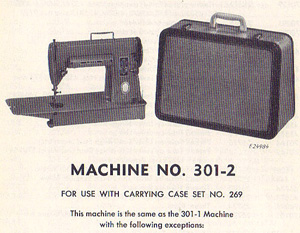
301-1 Short Bed Cabinet Model 301-2 Long Bed with Carry Case
-
The 301-1 used the 170027 bed extension. This is the short bed that is 3¼" in length. This makes sense because it is supposed to be used in a cabinet.
-
The 301-2 used the 170156 bed extension. This is the long bed that is 6" in length. This makes sense because it is supposed to be used as a portable with carrying case.
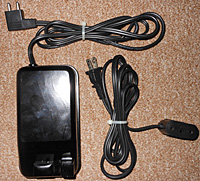
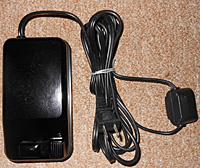
301-1 Foot Controller 194828 301-2 Foot Controller 194584
-
The 301-1 used the 194828 foot controller. This has 2 separate wires. One has a two pin plug that connects to the bottom of the machine and the other wire has the 3 pin plug to the machine and electrical plug. Again, this is the cabinet model.
-
The 301-2 used the 194584 foot controller. It only has 1 wire with the controller and electric plug all together. You simply just plug in the 3 prong plug into the machine and electrical outlet. Again, this is the portable model.
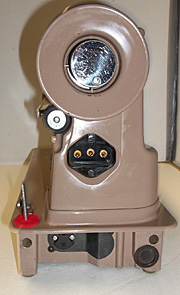

301-1 with cover 170129 301-2 with cover 170157
-
The 301-1 used the 170129 2 pin hole cover plate. This is the plate on the side of the sewing that the 2 pin plug plugs into. It has a hole in the plate with the plug in it. Again, needed with cabinet use.
-
The 301-2 used the 170157 cover plate. This plate did not have a hole in it for the 2 pin plug. It was one solid piece. Again, this is for portable use so there is no need for a 2 pin plug.
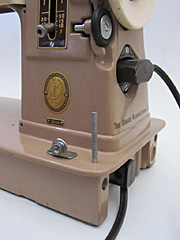
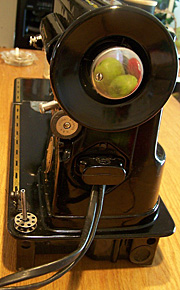
301-1 with 196222 wiring harness 301-2 with 196778 wiring harness
-
The 301-1 used the 196222 complete wiring harness. This wiring harness consisted of 2 separate wiring leads to make it work as a cabinet model.
-
The 301-2 used the 196778 single wiring harness. This wiring harness consisted of one 3 prong connector with 2 wiring leads to make it work as a portable model.
The Singer Model 301-3
High School Home Economics Class
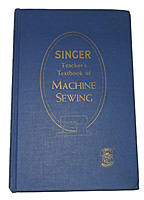
Singer Teacher Textbook of Machine Sewing
Singer has been part of the High School Home Economics for many years with several types of sewing machines like the 15-88, 15-91, 66, 127 and 201. The new Slant-needle machine would not only be marketed as a "Family Sewing Machine" but also as the "Slant Shank System" to educators and high school economics.
Purchase orders were drafted in advance requiring the "Slant Shank System" thereby securing Singer's market share in schools. Singer felt that the education system would produce a new generation of sewers raised on the slant shank or Slant-needle sewing machines.
The new "Slant-Needle" Singer Model 301 would be the first slant shank system sewing machine in high school home economics in 1953. It was an immediate success as teachers soon realized that no matter what students did to this machine it kept on sewing, hardly needing any repairs, and was deemed indestructible. The Singer Teacher's Textbook of Machine Sewing was published in 1953 and the front cover has an outline drawing of the Singer Model 301, a very informative book. In the 1958 Textbook the Singer 301 was still be used.
The "Singer Model 301" was deemed "Indestructible" in High Schools
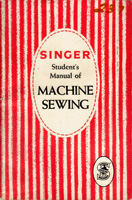
Student Manual of Machine Sewing
Students received a Student Manual of Machine Sewing specially prepared for students in Schools and Colleges. Machine covered in this manual were the Model 201, 66, 15 and 301.
Grand Introduction of the new Slant-needle "Singer Model 301"
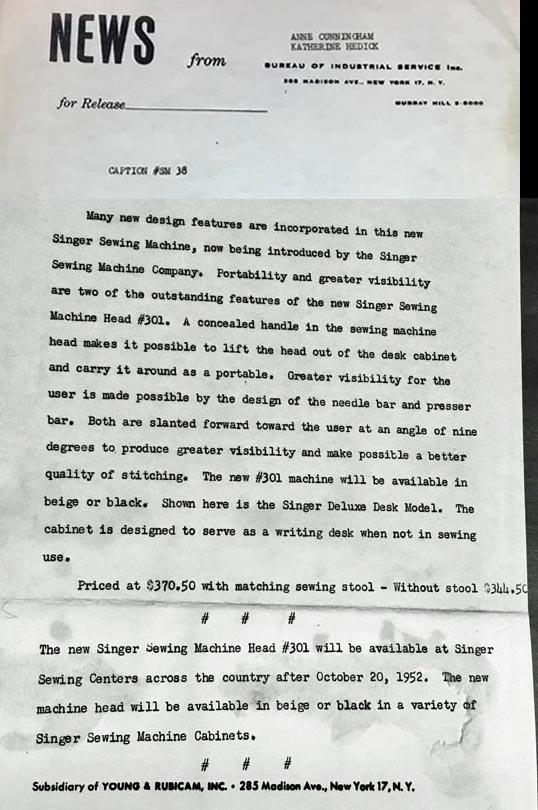
News letter: New Singer 301 available after October 20, 1952
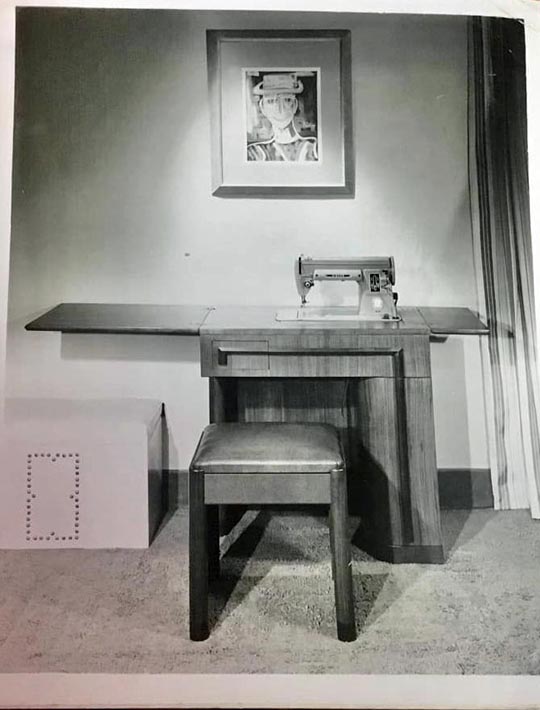
Singer 301 with Deluxe Desk Model No. 42 / Priced at $370.50 with matching sewing stool
1952 Original Sales Brochure
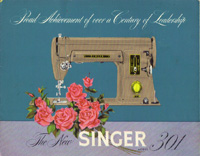
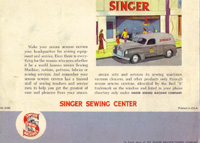
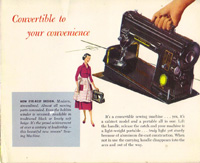
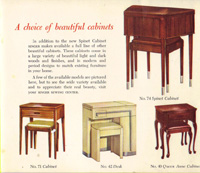
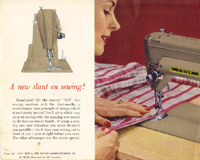
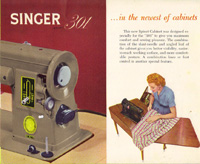
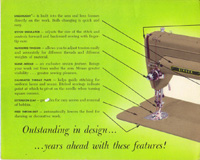
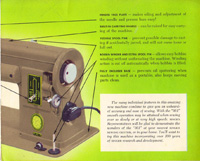
The Original Sales Brochure used for the Grand Introduction of the Singer 301 in October 1952
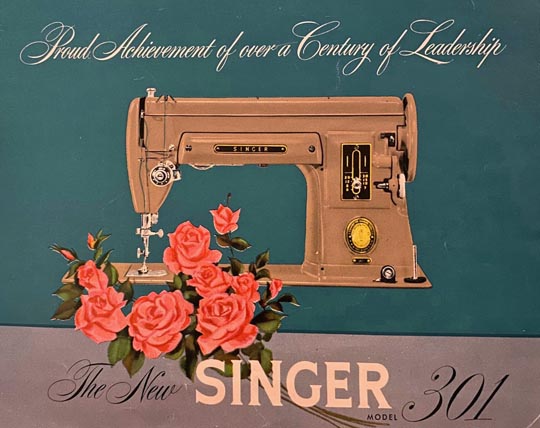
If you look closely, the new Singer 301 has a Centennial Badge!
The Grand Introduction of the new Singer Model 301 occurred after 20 October 1952 and corresponds exactly when nationwide advertising began in late October 1952. Interestingly, this date corresponds exactly to one year prior, October 1951, when a "Limited Production Run" of 10,000 Singer Model 301 sewing machines, the "Anniversary Model" to commemorate Singer's 100 Anniversary, were available at Singer Service Centers with absolutely no advertising or Grand Introduction. The "Green" Instruction manual for the "Singer 301 Anniversary Model" is dated with a copyright of (1051) or October 1951. This was a mystery until this website figured it out.
Singer 301 Advertisements
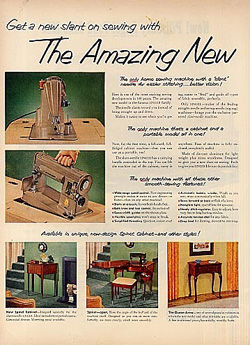
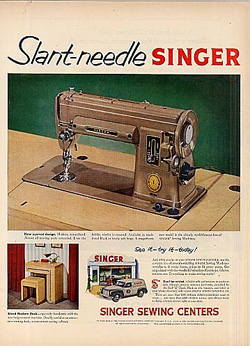
The Singer 301 was 1st advertised in October 1952
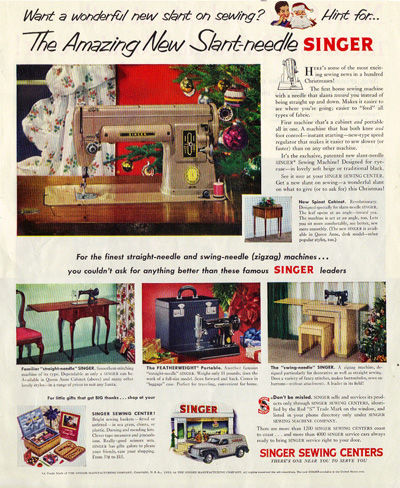
Christmas 1952 Singer 301 Advertisement

1953 Advertisement - The Amazing New Slant-needle Singer
"The Most Exciting Sewing Development in 100 years"
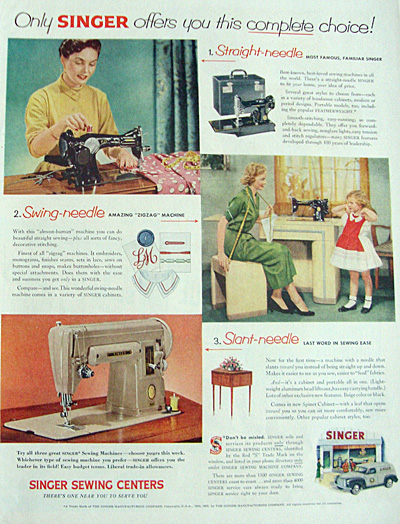
Slant-needle "Last Word In Sewing Ease"
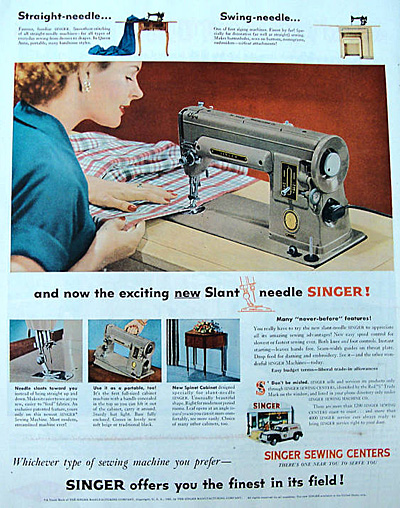
and now the exciting new Slant-needle Singer!
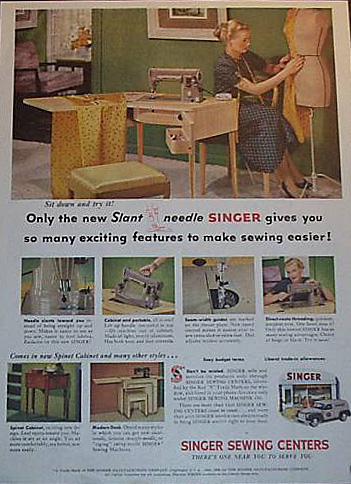
Only the new Slant-needle Singer gives you so many exciting features to make sewing easier!
Did you notice anything strange about the 1952 and 1953 advertisements? None of them displayed a traditional black color Singer 301. This was because Singer was trying to get customers to change their traditional views of sewing machines to a modern view by only displaying the "Soft Beige" color with no decals. The advertisements were also getting housewives ready for the 1956 new two-tone, "Oyster-White and Solid Beige" color.
Green Cover Instruction Manual
When a "Singer 301 Anniversary Limited Edition" was sold they were issued a "Green Cover" instruction manual. The revised date of (1051) or October 1951 corresponds exactly when first sold. With only 10,000 instruction manuals printed it is extremely "Super-Rare".
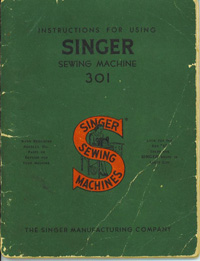
Singer 301 Green Cover Instruction Manual
Copyright 1935, 1936, 1938, 1940, 1947, 1948, 1950 and 1951: (1051), 60 pages.
The First Singer 301 Instruction Manual
(1051) or October 1951 was the date of the first published manual
This "Super Rare" Green Cover Manual was only issued with Singer 301's manufactured in "1951"
Description from the "Green Cover" Instruction Manual
The Singer 301 is an entirely new style of electric family sewing machine, embodying many exclusive features that simplify operation, make sewing a pleasure and assure a life-time of satisfactory service.
The arm, bed and several other parts are made of aluminum die castings which reduce the weight to the minimum.
It can be easily removed from the cabinet and used as a portable machine, a hinged handle, built into the top of the arm, making it convenient to carry.
It has a concealed, built-in electric motor which drives the machine through gears at any desired speed. A built-in electric SINGERLIGHT illuminates the work.
The machine has a rotary sewing hook on a horizontal axis and makes the lock stitch. It has reverse feeding mechanism which enables you to sew either in a forward or backward direction, making it easy to "back tack" and to fasten the ends of seams.
It has an inclined needle bar and pressure bar for easy vision of the work.
A wide range of material and thread can be handled and bulky work is readily accommodated on the spacious bed.
A convenient feed throw-out device, which renders the feed inoperative, permits darning and embroidering to be done without the use of a feed cover plate.
In addition to plain sewing, a large variety of pleasing effects such as hemming, binding, edge stitching, shirring, ruffling, etc., can be produced with the aid of the attachments furnished with the machine. These attachments and other popular Singer Fashion Aids will enable you to obtain the much desired tailored appearance of professionally-made garments and to add the new fashion touches demanded by swiftly changing styles at a fraction of the cost of ready-made garments.
The New "Black Cover" Singer Sewing Machine 301 Instruction Manual
Manuals now have Revised dates from the Original Green Cover Instruction Manual (1051) October 1951
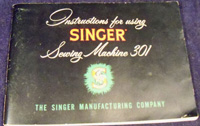
Here are all the Revised Dates
Copyright 1951 and 1952, Revised (652), 64 pages.
Copyright 1951 and 1952, Revised (153), 64 pages.
Copyright 1951, 1952 and 1953, Revised (653), 64 pages.
Copyright 1951, 1952, 1953, Revised (1153), 64 pages.

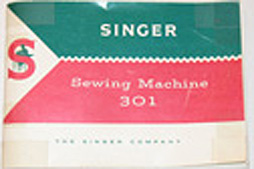
Copyright 1956, Revised (356), 70 pages.
In 1956 their were 2 manuals, a Black and Colored Cover
Description from the "Black/Colored Cover" Instruction Manual
Revolutionary Singer 301 Slant Needle Sewing Machine . . . represents the ultimate in sewing machine design and styling. A product of the matchless skill and engineering ability of Singer craftsmen, the Singer 301 is an outstanding addition to our long line of unexcelled Sewing Machines.
You have a machine revolutionary in design, but made with the same care and craftsmanship that have been the hallmark of Singer Machines for more than a century. We are acutely aware that Singer Sewing Machines have become an American tradition and are intensely proud of, and determined to continue this heritage.
Your Singer "301" is the product of this pride, determination and the unsurpassed technical skill of Singer. This smooth running machine-of-tomorrow will amaze and thrill you with its versatility and ease of operation.
Utilize all the advanced features, combine them with you own skill and discover a new world of sewing enjoyment. Exclusive dresses for yourself, clothing for your family and a multitude of items for your home will be yours - all at a fraction of their ready-made cost.
Notice how the description changed from the Green Cover Manual to the Black/Colored Cover Manual
To You...as the Owner of a new Singer Sewing Machine!
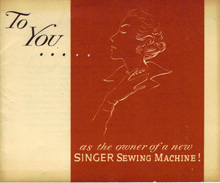
Along with the Green Cover Instruction Manual in 1951 you also received this pamphlet: To You...as the Owner of a new Singer Sewing Machine! As a New Singer Owner You are assured complete service and a complete course in home sewing. Inside the pamphlet it shows the lessons that you will receive.
The Best Sewing Machine Ever Made
Singer made some very good sewing machines over the past 100 years, 1851-1951, but the Singer 301 would be the first sewing machine to start a new century and they wanted a very special sewing machine. They took 100 years of engineering knowledge that would revolutionize sewing machines of tomorrow with an entirely new style of electric family sewing machine. The Singer 301 "The Most Exciting Sewing Development in 100 Years".
Some people say that the Singer 201 is the best sewing machine ever made or the Singer 221 featherweight is the perfect portable machine, but the Singer 301 is like having both sewing machines combined into one.
Singer stated - the Singer 301 represents the "Ultimate" in sewing machine design. In other words the Singer 301 was the end of a process, of the best achievable or imaginable of its kind, the highest in degree or order. Singer engineered, "The Best Sewing Machine Ever Made" in the past 100 years and holds true today.
When it comes to straight stitch sewing or quilting the Singer 301 offers lightweight portability, carrying handle, full size for cabinet use, vertical rotary hook and bobbin case, drop feed for free motion, up to 1600 stitches per minute and most of all the perfect lockstitch, Stitch Type 301. The most simple machine specifically engineered for precision with the fewest amount of moving parts will always make work easier and the best made machine.
I have read many comments from owners who have stated repeatedly that the Singer 301 is "The Best Straight Stitch Sewing Machine" and that their sewing machine repairman suggested the Singer 301 because it is one of the best sewing machines you could ever buy. I can attest to these statements as I have a 221, 201-2 and 301 but in all fairness I have to say the "Best Sewing Machine" is the Singer 301. It truly is Amazing.
Statements from sewing machine repairmen, collectors, owners all say the same thing
Statement from repairman: With over 60 years of industrial and home sewing machine repair the Singer 301 is "The Best Straight Stitch Sewing Machine Ever Made". The 301 hardly ever breaks down and only requires a cleaning and oiling. This machine is a workhorse with more piercing power than all the older models, it is much smoother to operate, has the best lock stitch, and a pleasure to sew on. That is what precision engineering is all about, only wish they still made them that way...
Statement from repairman: The Singer 301 in my opinion is absolutely without a doubt "The Finest Straight Stitch Sewing Machine Ever Made"... even better than the legendary Singer 221 and 201-2, my expertise is based upon over 80,000 sewing machine repairs over a span of 42 years, now retired.
Statement from repairman: With over 24 years of sewing machine repair experience "The 301 is the Best and Most Beautiful Sewing Machine Singer Has Ever Made" through the ages. It is ultra strong with such a nice stitch that will easily sew through denim, suede, canvas, upholstery, leather, vinyl and on top of all that it is excellent on delicate fabrics. In my book the 301 should be considered an industrial machine instead of a home sewing machine. This Singer sewing machine will surely last a lifetime and more if you oil and clean it, that's all. It is a very high quality and strong sewing machine.
Statement from collector: The Model 221 Singer Featherweight continues to be desired by people who generally want to use them but the Singer 301 has vastly gained in popularity and value mainly because it is "The Best Quality Straight Stitch Sewing Machine Ever Produced", bar none.
Statement from owner: A Singer 301 joined my family, 15-91 / 201-2 / 221, and is now my favorite, bestest, "Most Wonderful Fantastic Machine EVER"!!! Why didn't anyone ever let me in on this secret? Take the smooth sewing action of the 201, the speed and power of the 15-91, the portability of a 221, add a slant shank - wrap them all up into one machine. You now have this "Ultimate Machine". It really has the best of ALL features from my other machines and it is the hands down winner for speed. None of the others even come close . . . the 301 was nearly three times faster than the 201-2 and double the average of my other machines, that leaves it the "Indisputable Champion".
Statement from owner: I love the Singer 301 sewing machine! In 1986 I went to a Singer Store looking for a sewing machine for my daughter. The sales woman pointed to a used Singer Model 301 and said it was "The Best Sewing Machine" in the store - better than any new Singer sewing machine they had. I bought that 301 that day and it's still going strong at my daughter's house.
Singer Sewing Machines Review: This brings us to the last of the Classic Blacks, and a completely unique machine. To me, the 301 is the pinnacle of Singer sewing machines. It ushered in a new era of completely re-engineered slant shank machines - this machine was revolutionary! - and at the same time the black model was the very last of the beautiful black machines with gold decals. This was a new era and Singer wanted to modernize the look; the black machines were old school. Therefore the 301 had the black & gold version (for those who still liked the traditional style) and two more colors schemes in beige tones to update the look. To this day it remains unique because it was the only machine that could be both a cabinet AND a portable model. It has a vertical rotary hook like the featherweight and shares its 221 bobbin, but the slant shanks that followed (known as Slant-O-Matics) were horizontal rotaries with a Class 66 bobbin. The 301 is truly one of a kind; it is the bridge between all the Singer models above (and many, many more of that era) and the ones that followed. No machine ever made, however, could surpass it. Dare I say it is perfect?
After the many comments from owners, over 100 years of expert sewing machine repair, my experience and knowledge of sewing machines and how Singer felt about the Singer 301, there is only one conclusion when it comes to a straight stitch sewing machine . . . the "Singer 301" is without a doubt "The Best Sewing Machine Ever Made", period.
The World's Finest Straight Stitching Sewing Machine
The Singer 301 is undoubtedly the "Pinnacle" of all Singer Straight Stitching sewing machines!
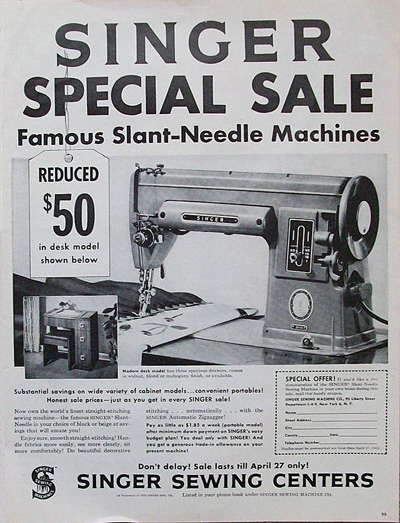
This 1958 Singer advertisement states: Now own the world's finest straight stitching sewing machine -- the famous Singer Slant-Needle in your choice of black or beige at savings that will amaze you!
For Singer to advertise and say it is "The World's Finest Straight Stitching Sewing Machine" surely expresses how Singer and customers felt about the Singer 301 compared to all straight stitching sewing machines.
The word "Finest" means; of superior quality, higher than or surpasses another in quality.
The Singer 301 is undoubtedly the "Pinnacle" of all Singer straight-stitch sewing machines representing the highest quality precision sewing machine that Singer could make and built to last a lifetime.
The World's Finest Straight Stitch Sewing Machine
The Best Selling Straight Stitch Sewing Machine
I researched the quantities of all of Singer's vintage straight stitch sewing machines over the years. Prior to the Singer 301 the best sellers were the Singer 201/201K and 221/221K but was very surprised to find out that the Singer 301/301A was the best selling straight stitch sewing machine during its time.
The Singer 301/301A was only sold in the U.S./Canada. It had better sales than the Singer 201K and 221K in the overseas market combined. It had better sales than the Singer 201 and 221 in the U.S. market combined. It also had better sales than the 221 and 221K Featherweights combined worldwide.
United States & Canada sales: The Singer 201 from 1932-1957 sold 716,905 in 25 years. The 221 Featherweight from 1933-1963 sold 1,640,000 in 30 years. The Singer 301 sold 10,000 from Oct-Dec 1951 and 690,000 from October 1952 to April 1958 or 700,000 in less than 6 years.
The Singer 301/301A was the Best Selling Straight Stitch Sewing Machine
The Singer 301 Makes a Perfect Stitch
There is no question that a straight stitch only sewing machine will always make the best straight stitch but what about the difference rotary hooks make. The Singer 301 has a vertical rotary hook with bobbin case and despite personal preferences will always make a more precise and stronger stitch than a horizontal rotary hook.
A horizontal rotary hook has to make a 90° angle in the stitch formation process, putting a lot of drag on the top thread. It also picks up lint quickly, requires more cleaning and is more susceptible to thread jamming. The real reason for the horizontal rotary hook with drop-in-bobbin is to be able to see how much thread you have left on the bobbin and its simplicity to the operator. That's it -plain and simple.
The vertical rotary hook is more sturdy, does not go out of alignment as readily, less susceptible to thread jamming, less lint build up that requires less cleaning, and the thread loop rotates in the same plane as the needle, it does not bend and twist the thread, making the perfect stitch.
The Singer 301 with vertical rotary hook makes the Perfect Stitch
Quilters Dream Machine is the Singer 301
For quilters, the sewing machine of choose used to be the Singer 221 Featherweight but not any more. The Singer 301 has become the new Quilters Dream Machine and it keeps increasing in popularity due to its larger size, more powerful metal gear driven motor, built-in lift up handle for carrying, it's lightweight and the Slant-needle providing better vision for ease of sewing. Quilters also much prefer the vertical rotary hook and easy to use drop-feed. Ask any owner and they will all tell you how much they love this sewing machine
The Singer 301/301A is the Quilters Dream Machine
Putting Them To The Test
I read an article "Putting Them To The Test" and decided on doing my own test.
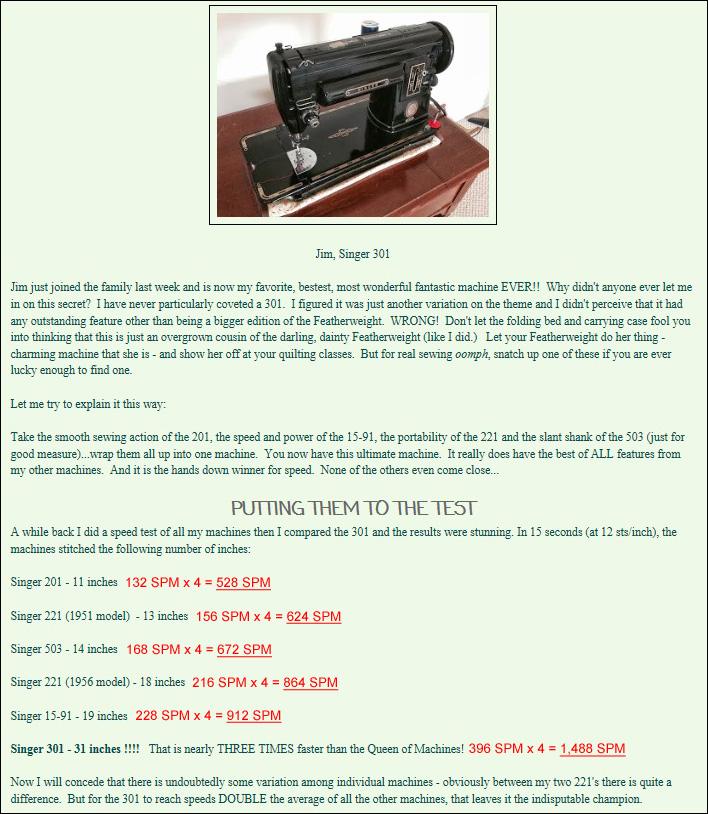
The Singer 301 is the Ultimate Sewing Machine and indisputable champion
Being very curious I decided to conduct my own test. I brought out my 1951 Singer 201-2 Centennial, my daughters 1952 221 Featherweight and my 1951 Singer 301 Centennial Limited Edition. I made sure each machine was doubled checked with 12 Stitches Per Inch (SPI), oiled, and with the same foot controller, than did the 15 second test (x 4 = SPM) at 3 runs per machine to get an average.
"Putting Them To The Test" - My 201-2 tested at 11 inches or 528 stitches per minute (SPM), exactly the same as the test above. My 221 Featherweight was 21 inches or 1,008 SPM, better than the test above. My 301 was 33.5 inches or 1,608 SPM, better than the test above.
The Singer 201-2 is the slowest with two different machines tested at 528 SPM. For sure it is quiet and this makes perfect sense attributed by its heavy construction and low stitches per minute. It may have a .6 amp potted motor with good piercing power but a very slow acceleration rate. Maybe this is why nobody wants to mention the stitches per minute of the Singer 201-2 that is probably rated at 500-550 SPM.
I did not have a Singer 15-91 to test but did find another test result with 903 SPM, only 9 stitches differences from the test above with 912 SPM. It looks like the Singer 15-91 is about 900 Stitches Per Minute with the same .6 amp potted motor as the Singer 201-2. You would think with the same motors the 15-91 and 201-2 would have a fairly close SPM, but this is not the case. Most people agree, even without a SPM test, that the 15-91 is in fact faster than the 201-2.
The 221 Featherweight with 1,000 SPM is spot on. The Featherweight makes the 201-2 seem very slow.
The Singer 301 at 1,608 SPM is in a class of its own. Being a little surprised at the result I tested another one of my 301's at 1620 SPM, Wow! The Singer 301 sews up to ±1,600 SPM.
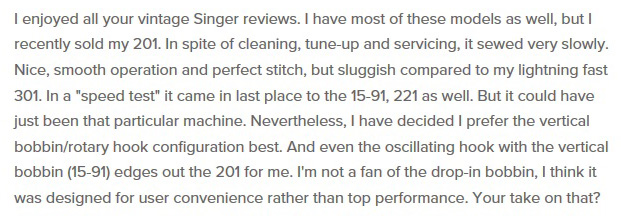
Speed test: although no results were shown, the order was correct. The Singer 201-2 was the slowest, than the Singer 15-91, the 221 Featherweight, and of course the Singer 301 - lightning fast.

Singer review: The Singer 301/301a is capable of achieving a top speed north of 1,600 stitches per minute. One tested around 1,620 SPM, the same result as one of my 301's.
The Singer Model 301 sews up to ±1,600 stitches per minute
Singer Model 404 Slant-Needle Deluxe
After the astonishing success of the Singer 301 Slant-Needle it was replaced in 1958 by the Singer Slant-needle Model 404 Deluxe made at the Elizabethport factory in New Jersey. In response to it's unpopularity and poor sales Singer stopped manufacturing it 2 years after it was introduced with 400,000 being made. However, a small batch of 1,500 machines were made in 1963 bringing the total to 401,500.
When you look at the picture below the Singer 404 looks very much like the later LBOW Singer 301A but it did have some changes; no carrying handle, no extension bed, front horizontal rotary hook, throat plate lever, ¼" longer in length and it gained 6 pounds.

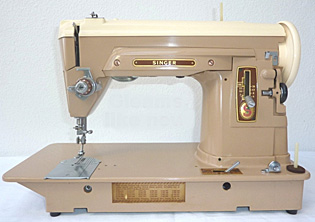
The Singer 301 was known as the "Worlds Finest Straight Stitch Sewing Machine" but Singer took advantage of the 301's success and advertised the new 404 . . . the finest straight stitch sewing machine ever built. They did the same with the 401A . . . the greatest sewing machine ever built. Ironically, they never sold one machine to find out if either machine was really the best built - unlike the Singer 301 that went through the test of time.
We have two machines that look almost the same but which one was better built?
The Singer 404 was a full size cabinet model and weighed 22 lbs because it was a heavy duty machine The Singer 301 was full size and a portable and weighed just 16 lbs. The 301 had a carry handle making it easier to move or take to sewing classes, it has a folding extension bed with a short or long bed, the long bed making it 2½" longer than the Singer 404.
The Singer 404 has a horizontal rotary hook with drop-in bobbin. The Singer 301 has a vertical rotary hook with bobbin case that is more sturdy, does not go out of alignment as readily, less lint build up that requires less cleaning, less susceptible to thread jamming, and the thread loop rotates in the same plane as the needle, it does not bend and twist the thread. A vertical rotary hook despite personal preferences will always make a more precise and stronger stitch than a horizontal rotary hook. For free-motion quilting the vertical rotary hook and bobbin case is much more desirable than the horizontal rotary hook with drop-in bobbin.
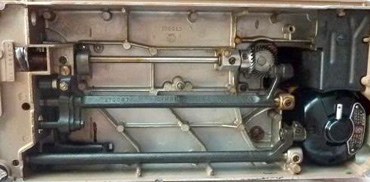
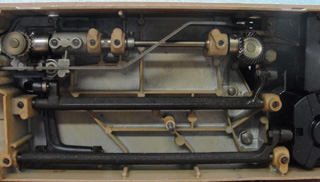
Singer 301 - Vertical Rotary Hook Singer 404 - Horizontal Rotary Hook
A basic principal in mechanical engineering, "The fewer moving parts, the better." No truer words ever spoken in context of engineering. The amount of moving parts in a machine is a factor in its mechanical efficiency, less moving parts, the greater the efficiency. The picture above clearly shows that the Singer 301 has much less moving parts compared to the Singer 404.
The Singer 404 has a throat plate lever that raises the pressure plate for darning and free motion quilting that was disliked along with the lever problems. The Singer 301 has a drop feed by turning a thumb screw the feed is rendered inoperative and will not interfere with the free movement of work. For free-motion quilting the drop feed of the Singer 301 is far better than the Singer 404 with a throat plate lever.
The 301 only needs a .53 amp motor to sew up to 1,600 stitches per minute (SPM). The 404 needs a .7 amp motor to sew up to 1,300 SPM. Imagine if the Singer 301 had a .7 amp motor.
Wow! Yes, I installed a .7 amp motor into my daily 301. Ready for this, it sews over 2,000 SPM with ease, tested at 50 inches or 2,400 SPM. This told me all I needed to know when comparing a vertical rotary hook on a horizontal axis, Singer 301, to a horizontal rotary hook on a vertical axis, Singer 404, with both machines having a .7 amp motor.
Which is better built - the Singer 301.
When it comes to straight stitch sewing machine the Singer 301 offers lightweight portability, carrying handle, full size for cabinet use, vertical rotary hook and bobbin case, drop feed for free motion, up to 1,600 stitches per minute and most of all the perfect lockstitch, Stitch Type 301. The most simple machine specifically engineered for precision with the fewest amount of moving parts will always make work easier and the best built machine.
The Legendary Singer 301 ... The Worlds Finest Straight Stitch Sewing Machine Ever Built
Thank you for visiting the Singer 301 website!